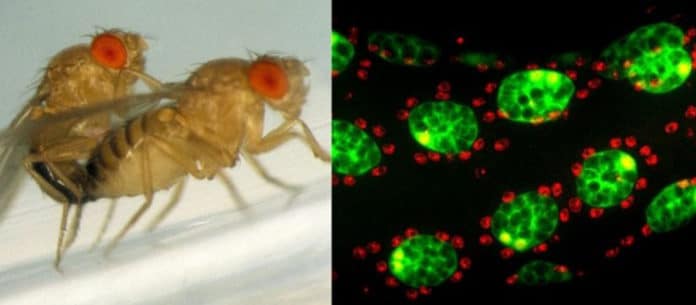In many species, mating induces physiological changes in the female that increase the mating pair’s reproductive success. This happens when a male’s semen that interacts with the female’s reproductive system.
The female physiological changes include increased ovulation and egg-laying, semen storage and release, dietary changes, and gut growth.
A mated female also becomes less receptive to other males and can use the semen stored in her spermatheca from her first intercourse for many days. However, this behavior is counterbalanced by the “last male preference” phenomenon.
However, sometimes females choose to mate with other healtheir males to have more robust offspring. In such a case, the semen of the first male is expelled, and only that of the last male is kept.
In this study, scientists studied the same phenomenon in Drosophila fly. They analyzed the proteins produced by the functional accessory gland, homolog of the human prostate.
The study was conducted in collaboration with Cornell University (USA) and the University of Groningen (Netherlands) by the University of Geneva (UNIGE).
Scientists discovered an RNA coding for a micro-peptide – a very small protein – that plays a crucial role in the competition between spermatozoa from different males with which the female mates.
Clément Immarigeon, a first author of this study conducted in the Department of Genetics and Evolution of the Faculty of Science at UNIGE, said, “Among the proteins, we identified as essential for a normal response after mating is a micro-peptide, a minimal protein that had never been studied before, as the RNA that codes for it were considered ‘non-coding.'”
Scientists created mutants to verify whether this phenomenon plays a determining role: In females first mated by a mutant male, the phenomenon of “last male preference” is no longer observed. Indeed, if another male then mates them, they lay eggs fertilized by the sperm of both males and not exclusively by the last progenitor, which could reduce their offspring’s robustness.
Robert Maeda, a researcher in the Department of Genetics and Evolution at UNIGE and last author of the study, said, “To our surprise, we found that this micro-peptide – encoded by a putative non-coding transcript – performs important reproductive functions. Such micro-peptides were not previously recognized but are emerging as important players in complex biological processes.”
Journal Reference:
- Clément Immarigeon et al. Identification of a micropeptide and multiple secondary cell genes modulate Drosophila male reproductive success. DOI: 10.1073/pnas.2001897118
